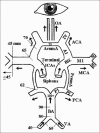Transcranial doppler: Technique and common findings (Part 1)
- PMID: 23956559
- PMCID: PMC3724069
- DOI: 10.4103/0972-2327.112460
Transcranial doppler: Technique and common findings (Part 1)
Abstract
Transcranial Doppler (TCD) can be aptly called as the doctor's stethoscope of the brain. Since its introduction in 1982, by Rune Aaslid, TCD has evolved as a diagnostic, monitoring, and therapeutic tool. During evaluation of patients with acute ischemic stroke, TCD combined with cervical duplex ultrasonography provides physiological information on the cerebral hemodynamics, which is often complementary to structural imaging. Currently, TCD is the only diagnostic tool that can provide real time information about cerebral hemodynamics and can detect embolization to the cerebral vessels. TCD is a noninvasive, cost-effective, and bedside tool for obtaining information regarding the collateral flow across various branches of the circle of Willis in patients with cerebrovascular disorders. Advanced applications of TCD help in the detection of right-to-left shunts, vasomotor reactivity, diagnosis, and monitoring of vasospasm in subarachnoid hemorrhage and as a supplementary test for confirmation of brain death. This article describes the basic ultrasound physics pertaining to TCD insonation methods, for detecting the flow in intracranial vessels in addition to the normal and abnormal spectral flow patterns.
Keywords: Ischemic stroke; intracranial stenosis; transcranial doppler.
Conflict of interest statement
Figures




Similar articles
-
Transcranial Doppler: Techniques and advanced applications: Part 2.Ann Indian Acad Neurol. 2016 Jan-Mar;19(1):102-7. doi: 10.4103/0972-2327.173407. Ann Indian Acad Neurol. 2016. PMID: 27011639 Free PMC article.
-
Advances in transcranial Doppler ultrasonography.Curr Neurol Neurosci Rep. 2009 Jan;9(1):46-54. doi: 10.1007/s11910-009-0008-7. Curr Neurol Neurosci Rep. 2009. PMID: 19080753 Review.
-
Transcranial Doppler and Transcranial Color Duplex in Defining Collateral Cerebral Blood Flow.J Neuroimaging. 2018 Sep;28(5):455-476. doi: 10.1111/jon.12535. Epub 2018 Aug 6. J Neuroimaging. 2018. PMID: 30084140 Review.
-
Transcranial Doppler ultrasonography in neurological surgery and neurocritical care.Neurosurg Focus. 2019 Dec 1;47(6):E2. doi: 10.3171/2019.9.FOCUS19611. Neurosurg Focus. 2019. PMID: 31786564 Review.
-
Trancranial Doppler: value in clinical practice.Int Angiol. 2009 Aug;28(4):249-53. Int Angiol. 2009. PMID: 19648867
Cited by
-
Pathophysiology, Management, and Therapeutics in Subarachnoid Hemorrhage and Delayed Cerebral Ischemia: An Overview.Pathophysiology. 2023 Sep 14;30(3):420-442. doi: 10.3390/pathophysiology30030032. Pathophysiology. 2023. PMID: 37755398 Free PMC article. Review.
-
Neurovascular coupling methods in healthy individuals using transcranial doppler ultrasonography: A systematic review and consensus agreement.J Cereb Blood Flow Metab. 2024 Dec;44(12):1409-1429. doi: 10.1177/0271678X241270452. Epub 2024 Aug 7. J Cereb Blood Flow Metab. 2024. PMID: 39113406 Free PMC article.
-
The Role of Transcranial Doppler Ultrasonography in the Diagnosis of Brain Death.Turk J Anaesthesiol Reanim. 2019 Oct;47(5):367-374. doi: 10.5152/TJAR.2019.82258. Epub 2019 Sep 1. Turk J Anaesthesiol Reanim. 2019. PMID: 31572986 Free PMC article. Review.
-
Monitoring cerebral vasospasm: How much can we rely on transcranial Doppler.J Anaesthesiol Clin Pharmacol. 2019 Jan-Mar;35(1):12-18. doi: 10.4103/joacp.JOACP_192_17. J Anaesthesiol Clin Pharmacol. 2019. PMID: 31057233 Free PMC article. Review.
-
Toward automated classification of pathological transcranial Doppler waveform morphology via spectral clustering.PLoS One. 2020 Feb 6;15(2):e0228642. doi: 10.1371/journal.pone.0228642. eCollection 2020. PLoS One. 2020. PMID: 32027714 Free PMC article.
References
-
- Aaslid R, Markwalder TM, Nornes H. Noninvasive transcranial Doppler ultrasound recording of flow velocity in basal cerebral arteries. J Neurosurg. 1982;57:769–74. - PubMed
-
- Moehring MA, Spencer MP. Power M-mode transcranial Doppler ultrasound and simultaneous single gate spectrogram. Ultrasound Med Biol. 2002;28:49–57. - PubMed
-
- Martínez-Sánchez P, Serena J, Alexandrov AV, Fuentes B, Fernández-Domínguez J, Díez-Tejedor E. Update on ultrasound techniques for the diagnosis of cerebral ischemia. Cerebrovasc Dis. 2009;27:9–18. - PubMed
-
- Yeo LL, Sharma VK. Role of transcranial Doppler ultrasonography in cerebrovascular disease. Recent Pat CNS Drug Discov. 2010;5:1–13. - PubMed
-
- Chernyshev OY, Garami Z, Calleja S, Song J, Campbell MS, Noser EA, et al. Yield and accuracy of urgent combined carotid/transcranial ultrasound testing in acute cerebral ischemia. Stroke. 2005;36:32–7. - PubMed
LinkOut - more resources
Full Text Sources
Other Literature Sources
Medical

